It’s Time for a New Core Curriculum
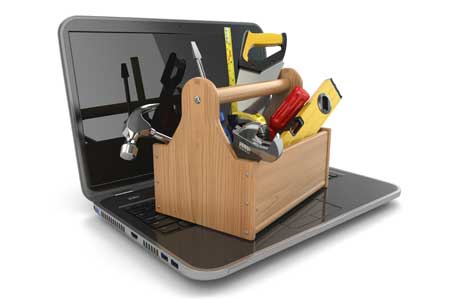
Language Arts, Math, Science, and Social Studies. For decades, these subjects have been the staple of the modern American educational system. The creative arts and physical education have also been played somewhat of a secondary role in that system. While all of these subject areas play a role in the development of our youth, they are based on career needs of the mid-20th century. According to this Pew Research study on Changes in the American Workplace, there has been an exponential demand on the social and analytical skills.
However, in our schools, we still teach the same “four core” areas and then fill in the rest with other subjects ranging from World Languages to Robotics. What’s interesting is, those original core 4 were considered the staple in preparing students for a 1950’s factory model work force. In this Sir Ken Robinson animated video, he talks about how our schools are designed for the assembly line. One only needs to look at the following graphic of companies that no longer exist to see that the American economy has shifted rapidly since the early 1970’s.
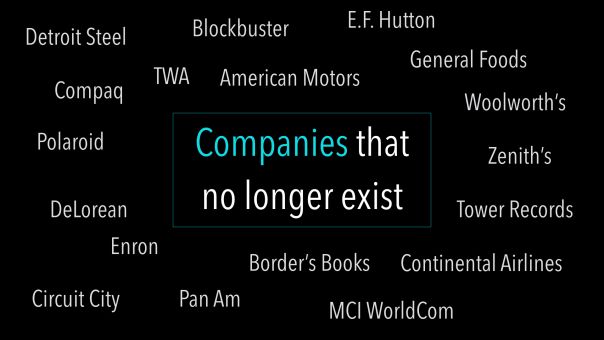
Compare the above with the graphic below which shows companies that didn’t exist in the early 1970’s that are now on Forbes top 200 list.
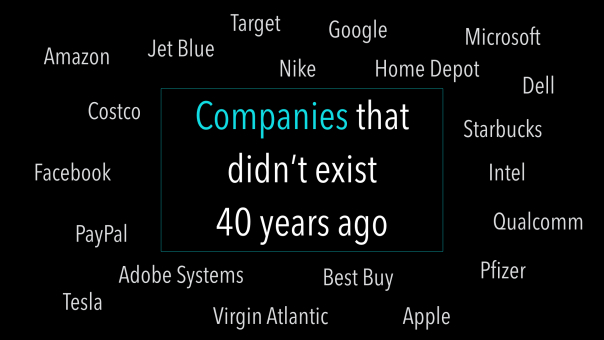
While there are some mainstays in terms of travel, service and retail companies, there is a huge growth in technology based companies. Now taking these new companies into account, let’s focus on the skills they desire for their future employee and see where schools stack up. This graphic by Tracy Clark (@tracyclark08) has been one that I’ve shared for many years. It’s sort of a “Soft Skills Bingo” chart of things that employers in those Fortune 500 companies look for when hiring.
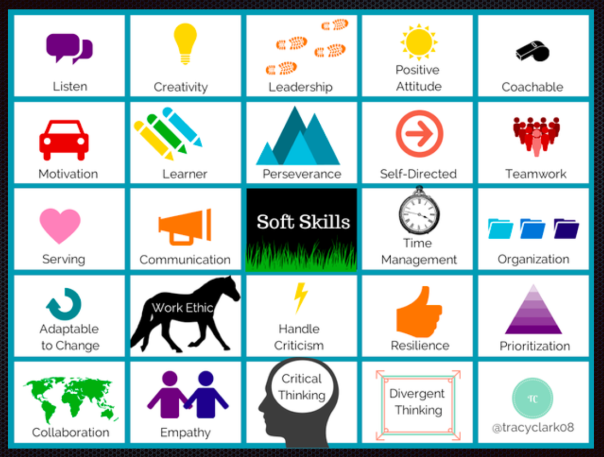
I don’t see any of the “core four” subjects listed on that chart. While you could definitely argue that communication plays a role in language arts and critical thinking plays a role in math and science, I start to wonder why we are trying to “fit” these soft skills into our 1950’s core?
What would a modern core curriculum look like? And probably even more importantly, how would we transition from the current curriculum to a more updated model?
Let’s break apart both of these questions so I can attempt an answer.
Tools and ideas to transform education. Sign up below.
Future Ready Curriculum –
If we were starting the American school system from scratch today, knowing what skills our students will need, we could change the subjects and not base them on what big-time publishers want us to focus on with our students. Building on some of the great work from FutureReady.org, the ISTE NETS for Students and keeping in mind those most desired future job skills from above, I would propose the development of the following 7 courses for every student:
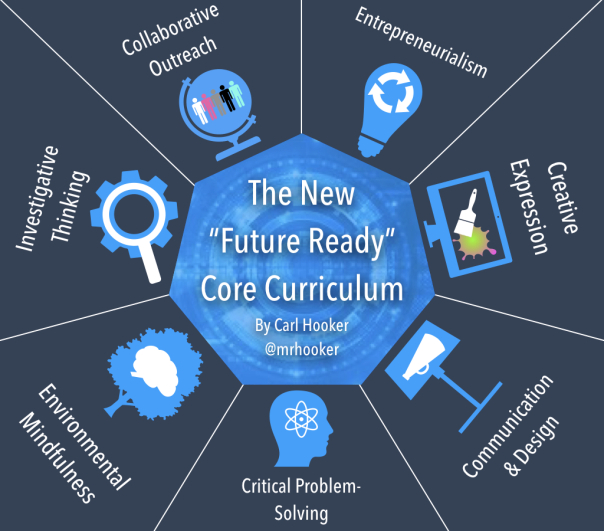
Collaborative Outreach – A way for students to both serve the communities around them, but also work in teams, plan projects, and practice empathy.
Entrepreneurialism – Thinking “outside-the-box” but in a class form. Many of the ideas from this class could work hand-in-hand with the other courses listed here. Again, working in teams, students create solutions or products with the goal of developing the entrepreneurial spirit.
Communication & Design – Oral and written communication still play a major role in our current system, and by all accounts they will in the future. However, what about visual communication? What about making a visually pleasing presentation to pitch a product or reflect on an outreach opportunity? This course would encompass those skills.
Creative Expression – Having outlets to express yourself creatively and time for passion projects is huge in the workplaces of Google and Apple. The same should be true for schools. This course could be all about an app you are designing or a sculpture you are trying to complete (either by hand or by 3D printing).
Critical Problem-Solving – Much of the curriculum from math and science would fall into this course, although elements would be sprinkled in the other courses (like economics in the entrepreneurial course and science in the Environmental Mindfulness & Outreach courses)
Investigative Thinking – This course takes many of the research skills taught in social studies and applies it with a twist. How can looking back and investigating history help predict future outcomes? Traditional statistics would play a role in this course too.
Environmental Mindfulness – We need to allow time for students to be outside and/or active during the traditional class day. We also need to allow time for students to reflect on what they have learned and set goals for their future. This course takes some of traditional P.E. and mixes in meditation and deeper thinking exercises as well.
Transition to the Future
Creating these courses is the easy part. The hard part would be transitioning our current core areas into the above. It will take me an entire new blog post to outline that plan for this transition, as it involves some heavy change in mindset (by both educators and community). In the meantime, here’s where I feel parts of our current courses would fit in the above new curriculum:
Mathematics – Critical Problem-Solving, Entrepreneurialism, Investigative Thinking
Language Arts – Communication & Design, Investigative Thinking, Creative Expression
Science – Critical Problem-Solving, Environmental Mindfulness, Collaborative Outreach
Social Studies – Investigative Thinking, Communication & Design, Collaborative Outreach
World Languages – Collaborative Outreach, Communication & Design
Fine and Performing Arts – Creative Expression
Physical Education – Environmental Mindfulness
Career and Technology – Entrepreneurialism, Collaborative Outreach, Creative Expression, Communication & Design
If we really want to prepare kids for what’s next, whether that be in a high-tech career or the service industry, we need to transition our curriculum into areas that will help them be more successful in a highly automated future. I feel like the new core curriculum I am proposing does that while at the same time folding in some of the ‘classic’ curriculum models of our educational fore-fathers.
What did I miss? Chime in on the comments below.
cross posted at http://hookedoninnovation.com
Carl Hooker has been a part of a strong educational shift with technology integration since becoming an educator. As Director of Innovation & Digital Learning at Eanes ISD, he has helped spearhead the LEAP program, which put one-to-one iPads in the hands of all K-12 students in his 8000-student district. He is also the founder of “iPadpalooza”- a three-day “learning festival” held in Austin annually. He's also the author of the six-book series titled Mobile Learning Mindset, a guide for teachers, administrators, parents and others to support and embrace mobile learning in our schools. Read more at Hooked on Innovation.
Carl Hooker has spent the past 20+ years in education as a teacher and administrator focused on the thoughtful integration of technology and innovation. He consults for multiple districts across the country and is a frequent speaker at state and national events. In his free time he's an author, DJ, podcast host, Poetry Slammer, and Trivia Night MC. He's the co-founder of the social platform K12Leaders.com. Check out his latest book Ready Set FAIL! Now available for order here: https://mrhook.it/fail Read more of his blogs at Hooked on Innovation.
